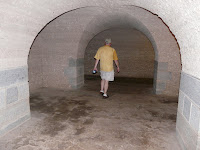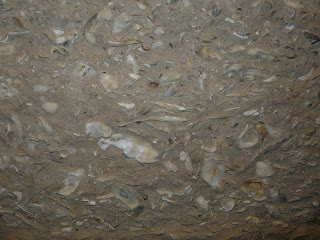Fort Pulaski

July 5: Fort Pulaski is one of the "third system" forts built following the War of 1812 to better defend the US coastline. It is located on Cockspur Island at the mouth of the Savannah River where it could control both the north and south channels of the river. It is named for the Polish Count Kazimierz Pulaski, a hero of the American Revolution who died at the Siege of Savannah (1779).
Like latter medieval fortifications, Fort Pulaski is surrounded by a moat, has a sally port with a drawbridge to demilune fortifications and then a second drawbridge onto the island.
The United States did not garrison Fort Pulaski after it was built. In January 1861, in anticipation of succession, the fort was seized by Georgia militia and later garrisoned by the Confederacy. Although third system forts were designed to withstand cannon attack, in April 1862 the United States breached the walls of Fort Pulaski using rifled cannon from nearby Tybee Island and thereafter occupied the fort. This act not only closed the port of Savannah for the duration of the Civil War but also ended the utility of Third Tier fortifications.
 The demilune and its drawbridge:
The demilune and its drawbridge:


The United States did not garrison Fort Pulaski after it was built. In January 1861, in anticipation of succession, the fort was seized by Georgia militia and later garrisoned by the Confederacy. Although third system forts were designed to withstand cannon attack, in April 1862 the United States breached the walls of Fort Pulaski using rifled cannon from nearby Tybee Island and thereafter occupied the fort. This act not only closed the port of Savannah for the duration of the Civil War but also ended the utility of Third Tier fortifications.
 The demilune and its drawbridge:
The demilune and its drawbridge:

 Inside the demilune:
Inside the demilune:

Walls made of tabby:
 Drawbridge to the sally port and its defense (l):
Drawbridge to the sally port and its defense (l):

Inside the fort [the round structure center right is the original cupola from the Cockspur lighthouse]:


A huge fig tree occupies the southwest corner of the more than 2 acre parade ground:
 The commander's quarters (with plexiglass reflection); A fire in the southwest part revealed the double-arch masonry (the arch overhead is mirrored by one below) used in the firing galleries to support the gun platform along the battlements above:
The commander's quarters (with plexiglass reflection); A fire in the southwest part revealed the double-arch masonry (the arch overhead is mirrored by one below) used in the firing galleries to support the gun platform along the battlements above:

Views through the gun loops in the firing galleries:



A cannon in the firing gallery; spiral stairs to the battlements:


On the gun platform:


From the battlements: A view of Cockspur Island Light (1855) which survived the Union bombardment of Fort Pulaski; A view of Tybee Lighthouse (1867) built on the foundation of the lighhouse burned by the Confederates when they evacuated Tybee Island:


Damage from the Union bombardment can be seen on the southern and eastern sides of the fort:


The fort was surrendered after rifled cannon breached the southeast corner of the fort and threatened the powder magazine; the repair of the breach is in the redder brick:



There was a 1.5 mile roundtrip foot trail from the fort to the overlook of Cockspur Island Light:


A black and yellow garden spider (Argiope aurantia) known for the stabilimentum in the center of its web and and a sea oxeye daisy (Borrichia frutescens):


 Even at low tide people must go by boat; View at high tide:
Even at low tide people must go by boat; View at high tide:

The casino boat heads out to sea for gambling in international waters:



0 Comments:
Post a Comment
Subscribe to Post Comments [Atom]
<< Home